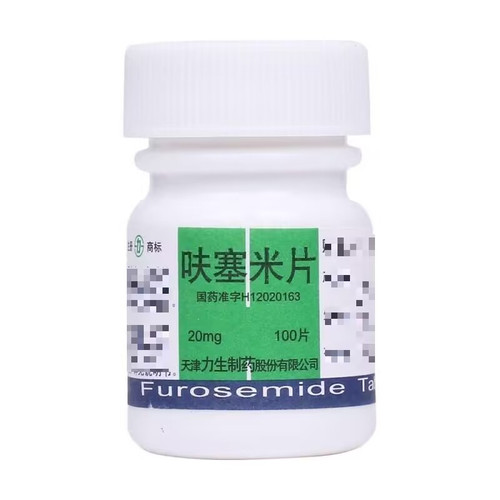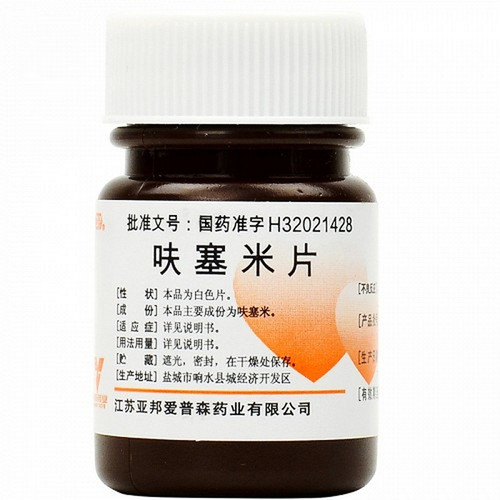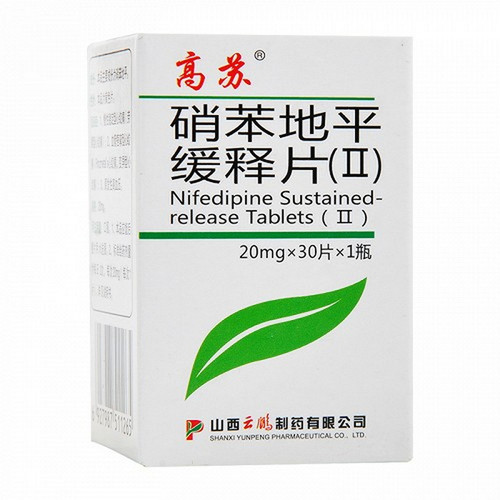Product Overview
[Drug Name]
Generic Name: Furosemide Tablets
Trade Name: Yunpeng Furosemide Tablets 20mg x 100 Tablets
[Main Ingredient]
The main ingredient of this product is furosemide.
[Properties]
This product is a colorless tablet.
[Indications/Main Functions]
1. Edema disorders including congestive heart failure, cirrhosis, and renal disease (nephritis, nephropathy, and acute and chronic renal failure due to various causes). This class of drugs may still be effective, especially when other diuretics are ineffective. It can also be used in combination with other drugs to treat acute pulmonary edema and acute cerebral edema. 2. Hypertension is generally not the first choice drug for the treatment of essential hypertension. However, this class of drugs is particularly suitable when thiazides are ineffective, especially when accompanied by renal insufficiency or hypertensive crisis. 3. Prevention of acute renal failure. This medication is used for various causes of insufficient renal blood perfusion, such as dehydration, shock, poisoning, anesthesia accidents, and circulatory insufficiency. Prompt administration while correcting hypovolemia can reduce the risk of acute tubular necrosis. 4. Hyperkalemia and hypercalcemia. 5. Dilutional hyponatremia, especially when the blood sodium concentration is below 120 mmol/L. 6. Syndrome of excessive antidiuretic hormone secretion (SIADH). 7. Acute drug poisoning, such as barbiturate poisoning.
[Specifications]
20mg x 100 tablets
[Dosage and Administration]
Oral administration: Adults 1. For the treatment of edematous diseases: Initial dose: 20-40 mg once daily. Additional doses of 20-40 mg may be administered after 6-8 hours, as needed, until a satisfactory diuretic effect is achieved. While the maximum daily dose can reach 600 mg, it should generally be kept within 100 mg, divided into 2-3 doses, to prevent excessive diuresis and adverse reactions. For some patients, the dose can be reduced to 20-40 mg every other day, or 20-40 mg daily for 2-4 consecutive days per week. 2. Treatment of hypertension: Initially take 40-80 mg daily, divided into two doses, and adjust the dose as appropriate. 3. Treatment of hypercalcemia: 80-120 mg daily, divided into 1-3 doses. For the treatment of edema in children, start with 2 mg/kg body weight, and increase by 1-2 mg/kg every 4-6 hours as needed. For neonates, the dosing interval should be extended.
[Adverse Reactions]
Common adverse reactions are related to fluid and electrolyte imbalances, especially with high doses or long-term use, such as orthostatic hypotension, shock, hypokalemia, hypochloremia, hypochloremic alkalosis, hyponatremia, hypocalcemia, and associated thirst, fatigue, muscle aches, and arrhythmias. Rare cases include allergic reactions (including rash, interstitial nephritis, and even cardiac arrest), blurred vision, xanthophthalmia, photosensitivity, dizziness, headache, anorexia, nausea, vomiting, abdominal pain, diarrhea, pancreatitis, muscle rigidity, bone marrow suppression leading to granulocytopenia, thrombocytopenic purpura, and aplastic anemia, liver damage, paresthesias of the digits, hyperglycemia, positive urine glucose, exacerbation of pre-existing diabetes, and hyperuricemia. Tinnitus and hearing impairment are more common with rapid intravenous injections of large doses (greater than 4-15 mg per minute). They are usually transient, but occasionally irreversible, especially when used concurrently with other ototoxic drugs. In the presence of hypercalcemia, nephrolithiasis may occur. There are also reports of this drug exacerbating idiopathic edema.
[Contraindications]
Not yet established.
[Drug Interactions]
1. Adrenal glycogen, mineralocorticoids, adrenocorticotropic hormone, and estrogen can reduce the diuretic effect of this drug and increase the risk of electrolyte imbalances, especially hypokalemia. 2. Nonsteroidal anti-inflammatory analgesics can reduce the diuretic effect of this drug and increase the risk of renal damage. This is related to their inhibition of prostaglandin synthesis and reduced renal blood flow. 3. Concomitant use with sympathomimetics and anticonvulsants can weaken the diuretic effect. 4. Concomitant use with clofibrate (clofibrate) can enhance the effects of both drugs and may cause muscle soreness and stiffness. 5. Concomitant use with dopamine can enhance the diuretic and antihypertensive effects of this drug. 6. Alcohol, alcohol-containing preparations, and medications that can lower blood pressure can enhance the diuretic and antihypertensive effects of this drug. Concomitant use with barbiturates and anesthetics can easily cause orthostatic hypotension. 7. This drug can reduce uric acid excretion and increase serum uric acid levels. Therefore, when used in combination with gout medications, the dosage of the medication should be adjusted appropriately. 8. Reduces the efficacy of hypoglycemic drugs. 9. Reduces the effects of anticoagulants and antifibrinolytics, primarily due to a decrease in blood volume after diuresis, which leads to increased coagulation factor concentrations in the blood, and improved hepatic blood supply and increased hepatic synthesis of coagulation factors due to diuresis. 10. This drug potentiates the effects of non-depolarizing muscle relaxants, which is related to a decrease in serum potassium. 11. Concomitant use with antibiotics such as amphotericin, cephalosporins, and aminoglycosides may increase nephrotoxicity and ototoxicity, especially in patients with pre-existing renal impairment. 12. Concomitant use with antihistamines may increase ototoxicity, leading to tinnitus, dizziness, and vertigo. 13. Concomitant use with lithium significantly increases nephrotoxicity and should be avoided. 14. Intravenous administration of this drug after taking chloral hydrate may cause sweating, facial flushing, and increased blood pressure. This is related to increased conversion of bound thyroid hormone to free thyroid hormone, leading to enhanced catabolism. 15. Concomitant use with sodium bicarbonate may increase the risk of hypochloremic alkalosis.
[Precautions]
1. Cross-allergy. Those who are allergic to sulfonamides and thiazide diuretics may also be allergic to this drug. 2. Interference with diagnosis: It can cause increased blood sugar and positive urine sugar, especially in patients with diabetes or prediabetes. Excessive dehydration can temporarily increase blood uric acid and urea nitrogen levels. The concentrations of blood Na+, Cl-, K+, Ca2+ and Mg2+ decrease. 3. Use with caution in the following situations: (1) Patients with anuria or severe renal impairment. The latter requires a higher dose, so the medication interval should be extended to avoid side effects such as ototoxicity; (2) Diabetes; (3) Hyperuricemia or patients with a history of gout; (4) Patients with severe liver damage, as water and electrolyte imbalance can induce hepatic coma; (5) Acute myocardial infarction, excessive diuresis can trigger shock; (6) Pancreatitis or patients with this history; (7) Patients with a tendency to hypokalemia, especially those using digitalis drugs or ventricular arrhythmia; (8) Lupus erythematosus, this drug may aggravate the condition or induce activity; (9) Prostatic hyperplasia. 4. Follow-up examination (1) Blood electrolytes, especially those who use digitalis or corticosteroids, or have liver and kidney function damage; (2) Blood pressure, especially for antihypertensive, high-dose use or for the elderly; (3) Renal function; (4) Liver function; (5) Blood sugar; (6) Blood uric acid; (7) Acid-base balance; (8) Hearing. 5. The drug dose should be taken from the most Start with a small effective dose, and then adjust the dose according to the diuretic response to reduce the occurrence of side effects such as water and electrolyte imbalance. 6. When hypokalemia or hypokalemia tendency exists, potassium salt should be supplemented. 7. When used in combination with antihypertensive drugs, the latter's dose should be adjusted as appropriate. 8. If the patient with oliguria or anuria still has no effect after 24 hours of taking the maximum dose, the drug should be discontinued.
[Drug use in children]
The half-life of this drug is significantly prolonged in newborns, so the interval between doses for newborns should be prolonged.
[Drug use in elderly patients]
The chances of hypotension, electrolyte imbalance, thrombosis and renal damage increase when the elderly take this drug.
[Pharmacology and toxicology]
(1) Effect on water and electrolyte excretion. It can increase the excretion of water, sodium, chloride, potassium, calcium, magnesium, phosphorus, etc. Unlike thiazide diuretics, furosemide and other diuretics have a significant dose-effect relationship. As the dose increases, the diuretic effect is significantly enhanced, and the drug dosage range is large. This type of drug mainly inhibits the active reaction of the thick wall segment of the renal tubular medullary to NaCl. Reabsorption results in an increase in the concentration of Na+ and Cl- in the tubular fluid, while a decrease in the concentration of Na+ and Cl- in the medullary interstitial fluid, which reduces the osmotic pressure gradient difference and the concentrating function of the renal tubules, leading to increased excretion of water, Na+, and Cl-. Due to the decrease in Na+ reabsorption, the Na+ concentration in the distal tubules increases, which promotes increased Na+-K+ and Na+-H+ exchange, and increases the excretion of K+ and H+. As for the mechanism by which furosemide inhibits the reabsorption of Cl- in the thick-walled segment of the ascending limb of the renal tubule medullary limb, it was previously believed that there was a chloride pump in this area. Current studies have shown that there is a Na+ and Cl- paired transport system related to the Na+-K+ ATPase on the outside of the basement membrane of this area. Furosemide reduces the reabsorption of Na+ and Cl- by inhibiting the function of this system. In addition, furosemide may also inhibit the reabsorption of Na+ and Cl- by the proximal and distal tubules, and promote the secretion of K+ by the distal tubules. Furosemide increases the excretion of Ca2+ and Mg2+ by inhibiting the reabsorption of Ca2+ and Mg2+ by Henlein. Excretion. Short-term medication can increase uric acid excretion, while long-term medication can cause hyperuricemia. (2) Effects on hemodynamics. Furosemide can inhibit the activity of prostaglandin degrading enzymes, increase the content of prostaglandin E2, and thus have a vasodilatory effect. Dilation of renal blood vessels, reduction of renal vascular resistance, and increase of renal blood flow, especially blood flow in the deep renal cortex, are of great significance in the diuretic effect of furosemide and are also the theoretical basis for its use in preventing acute renal failure. In addition, unlike other diuretics, furosemide does not decrease the glomerular filtration rate while increasing renal tubular fluid flow, which may be related to the reduction of chloride flowing through the macula densa, thereby weakening or blocking the glomerular-tubular balance. Furosemide can dilate the pulmonary capacitance veins and reduce the permeability of pulmonary capillaries. In addition, its diuretic effect reduces the amount of blood returning to the heart and reduces the left ventricular end-diastolic pressure, which is helpful for the treatment of acute left heart failure. Since furosemide can reduce the permeability of pulmonary capillaries, it provides a theoretical basis for its treatment of adult respiratory distress syndrome.







